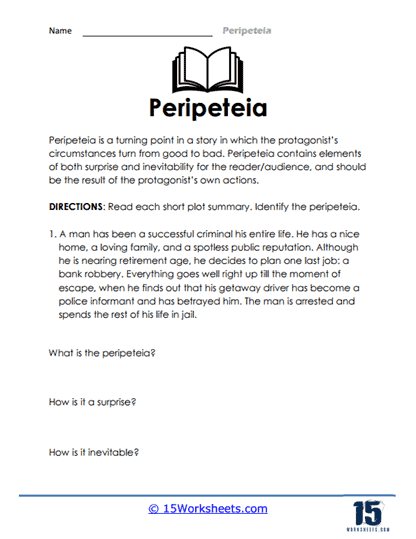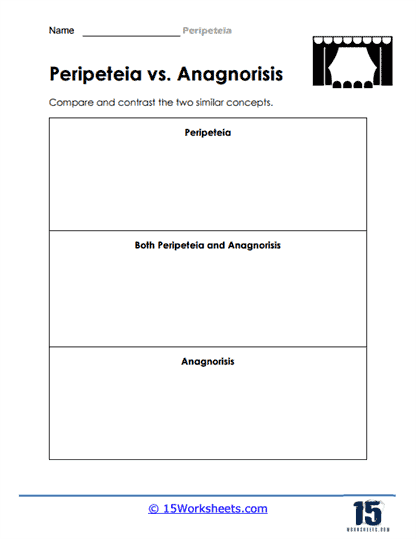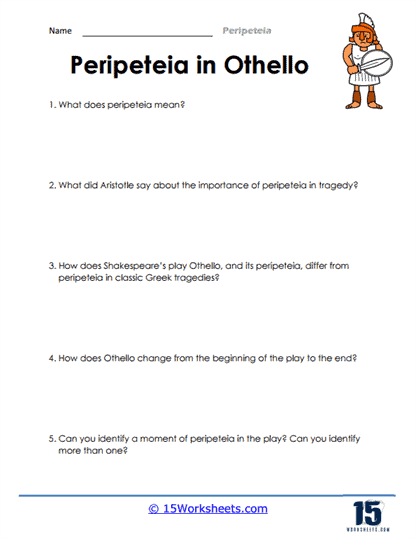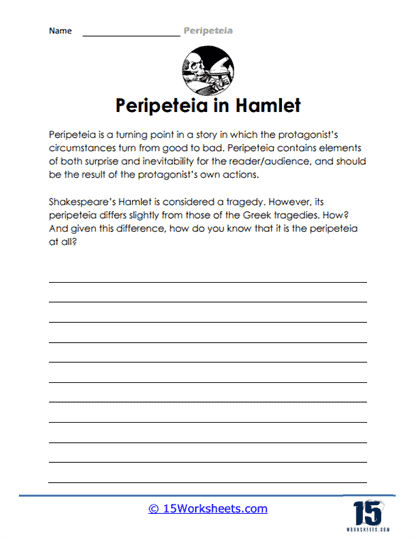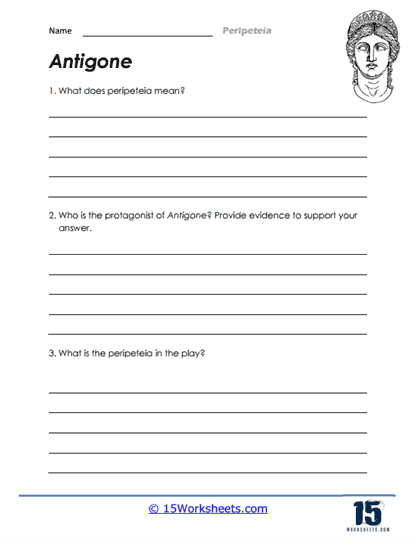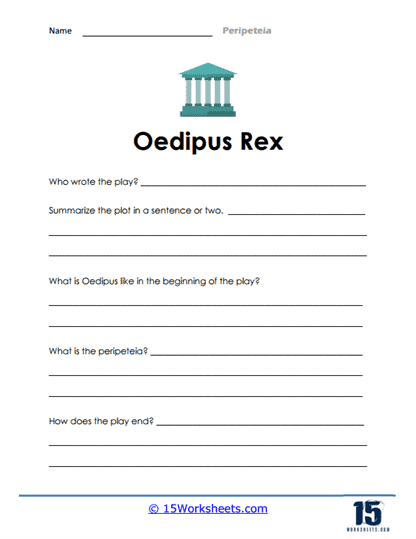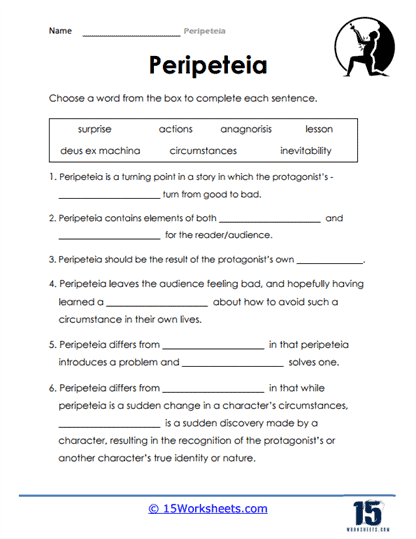Peripeteia Worksheets
About These 15 Worksheets
These worksheets enhance students’ understanding and engagement with literary concepts, particularly focusing on the critical turning points in narratives. The term “peripeteia” refers to a sudden reversal of fortune or change in circumstances, especially in the context of a dramatic narrative, making these worksheets particularly relevant to the study of literature and drama. By delving into the peripeteia of a story, students can gain deeper insights into the structure of narratives, character development, and thematic elements. These worksheets come in various types, each tailored to specific aspects of literary analysis and reading comprehension.
One of the primary types of exercises found on peripeteia worksheets focuses on identifying and analyzing the peripeteia in a narrative. Students are tasked with pinpointing the moment in the story where the dramatic reversal occurs and discussing its significance to the overall plot. This exercise enhances critical thinking and analytical skills, as students must not only identify the peripeteia but also interpret its impact on the narrative and the characters involved.
Another common exercise is the comparative analysis of peripeteia across different works of literature. This activity encourages students to explore multiple narratives, identifying the peripeteia in each and comparing how different authors employ this narrative device. Through this comparison, students can develop a deeper understanding of literary techniques and styles, as well as the universal themes that peripeteia often reveals.
Creative writing exercises are also a significant component of peripeteia worksheets. These activities challenge students to craft their own narratives or scenes incorporating peripeteia, thereby fostering creativity and a practical understanding of how to use literary devices effectively. Through creative writing, students not only apply their knowledge of peripeteia but also enhance their writing skills, exploring character development, plot construction, and thematic expression.
Character analysis exercises on peripeteia worksheets help students delve into the psychological and emotional dimensions of characters experiencing a reversal of fortune. By examining characters’ responses to peripeteia, students gain insights into character motivations, growth, and the narrative’s psychological depth. This exercise strengthens empathy and interpretative skills, as students learn to see the world from various perspectives and understand the complexity of human emotions and decisions.
Thematic exploration activities are integral to understanding the broader implications of peripeteia in literature. These exercises encourage students to reflect on the themes and messages that the peripeteia unveils within the narrative. By connecting the dramatic reversal to larger themes, students enhance their ability to interpret and appreciate the multifaceted layers of meaning in literary works.
Discussion and debate exercises on peripeteia worksheets foster collaborative learning and critical discourse. Students engage in discussions or debates about the significance of peripeteia in a narrative, its impact on the audience, and its role in conveying the author’s message. These activities promote oral communication skills, persuasive argumentation, and the ability to defend interpretations using evidence from the text.
Visual mapping exercises, such as storyboarding the peripeteia and its surrounding events, help students visually organize and analyze the narrative structure. By creating visual representations, students can more easily understand the sequence of events and the pivotal role of peripeteia in advancing the plot. This method appeals to visual learners and enhances students’ ability to summarize and synthesize information.
Practicing with peripeteia worksheets offers numerous benefits to students, particularly in enhancing their understanding of language arts and reading skills. These worksheets encourage active engagement with the text, requiring students to think critically about narrative structures, character development, and thematic elements. By analyzing and creating narratives that include peripeteia, students improve their analytical skills, learning to identify key literary devices and understand their effects on the narrative.
These exercises foster a deeper appreciation for literature, as students explore the complexity and nuance of narrative storytelling. Through the lens of peripeteia, students are exposed to a wide range of emotions, conflicts, and resolutions, enriching their emotional and empathetic understanding. This engagement not only improves reading comprehension but also cultivates a lifelong interest in reading and literature.
The creative and reflective aspects of peripeteia worksheets enhance writing skills and encourage personal expression. Students learn to incorporate sophisticated literary devices into their own writing, improving their ability to communicate complex ideas and emotions effectively. Additionally, by articulating their analyses and interpretations, students develop clear and persuasive writing skills, which are invaluable across academic disciplines and in future careers.
Collaborative exercises on peripeteia worksheets promote social learning and the development of communication skills. Through discussion and debate, students learn to articulate their ideas, listen to others, and refine their arguments. This collaborative environment fosters a supportive learning community where students can explore different perspectives and build upon each other’s ideas.
What is the Literary Device of Peripeteia?
Peripeteia, a term rooted in Greek tragedy, refers to a sudden and unexpected reversal of circumstances or fortune in a narrative, especially one that profoundly impacts the protagonist’s life and the story’s direction. This literary device is pivotal in creating dramatic tension and emotional depth, serving as a catalyst for character development and thematic exploration. Aristotle first coined the term in his “Poetics,” emphasizing its importance in the structure of tragic plays. The main defining feature of peripeteia is its unexpectedness and the significant shift it causes in the narrative’s progression, often transforming the story’s outcome in a way that deeply affects the characters and their fates.
The Characteristics of Peripeteia
Suddenness and Unexpectedness – Peripeteia occurs abruptly, surprising both characters and readers. This unexpected turn of events is not predictable and often catches everyone off guard, contributing to the narrative’s suspense and intrigue.
Reversal of Fortune – It involves a drastic change in the protagonist’s situation, often from good to bad or vice versa. This reversal is crucial to the plot’s development and the protagonist’s journey.
Impact on Plot and Character – Peripeteia is pivotal to the story, leading to significant changes in the plot and character development. It often marks a turning point where the protagonist must confront new challenges or reevaluate their choices and beliefs.
Enhancement of Dramatic Effect – This device amplifies the story’s emotional intensity, drawing readers deeper into the narrative and fostering a stronger connection with the characters.
Examples of Peripeteia in Literature
Oedipus Rex by Sophocles – Perhaps the most famous example of peripeteia is found in Sophocles’ tragedy “Oedipus Rex The play’s peripeteia occurs when Oedipus, who has been seeking the murderer of the former king to save Thebes from plague, discovers that he himself is the murderer and that he has unwittingly fulfilled the prophecy of killing his father and marrying his mother. This revelation turns Oedipus’s fortunes from that of a respected king to a disgraced outcast, highlighting the tragic irony and the devastating impact of fate and self-discovery.
Pride and Prejudice by Jane Austen – In this classic novel, a significant peripeteia occurs when Elizabeth Bennet reads a letter from Mr. Darcy explaining his actions regarding Jane and Mr. Bingley, as well as the truth about Mr. Wickham. This moment dramatically reverses Elizabeth’s feelings and judgments about Darcy. Before this point, she harbors strong prejudice against him; after understanding his true character and intentions, her feelings begin to shift, leading to the eventual resolution of their romantic misunderstandings and the union of two seemingly incompatible characters.
The Godfather by Mario Puzo – A modern example of peripeteia can be found in “The Godfather,” when Michael Corleone, who initially wants nothing to do with his family’s criminal empire, takes decisive action to avenge an assassination attempt on his father, Vito Corleone. This moment of sudden reversal not only changes Michael’s personal trajectory but also the future of the Corleone family, marking his transformation from a reluctant outsider to a powerful mafia boss.
The Effect of Peripeteia on the Reader
Peripeteia plays a significant role in shaping the reader’s experience by injecting unpredictability into the narrative, which captivates and maintains their interest. The emotional rollercoaster triggered by the sudden reversal of fortunes deepens the reader’s empathy for the characters and investment in the story. It challenges readers’ expectations and often leads to a reevaluation of the narrative and its characters, encouraging deeper engagement and reflection.
By confronting characters with unforeseen challenges or revelations, peripeteia also highlights their resilience, weaknesses, and the complexities of human nature. This nuanced portrayal of characters contributes to the story’s realism and relatability, allowing readers to see themselves in the characters’ struggles and triumphs.
Furthermore, peripeteia enhances the thematic richness of the narrative. It often serves as a vehicle for exploring themes such as fate vs. free will, the consequences of pride or ignorance, and the transformative power of knowledge or love. Through the dramatic shifts brought about by peripeteia, authors can delve into philosophical inquiries and moral questions, inviting readers to ponder life’s unpredictability and the nature of human existence.
Its ability to reverse fortunes suddenly and dramatically not only propels the story forward but also deepens the narrative’s emotional impact and thematic complexity. Through examples from literature, it is evident that peripeteia remains a powerful tool for storytelling, capable of transforming both the course of a narrative and the reader’s experience of it.

